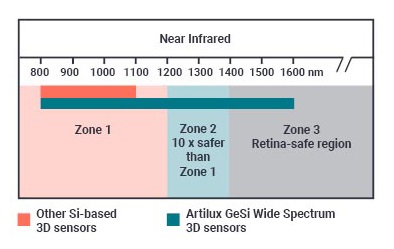By Gina Roos, editor-in-chief
Artilux is set to launch its Explore Series, claimed as the first wide-spectrum 3D time-of-flight (ToF) sensor based on germanium-on-silicon (GeSi), at the Consumer Electronics Show (CES ) in January. The new GeSi technology platform was developed by Artilux in cooperation with TSMC.
Operating at longer near-infrared (NIR) wavelengths, the 3D sensor can be used in the area of the spectrum that is more than 10 times safer than the currently used 940-nm wavelength, said the company, as well as improve sensing accuracy and performance under sunlight. The longer NIR wavelengths also minimize interference from sunlight and enable better performance in outdoor environments.

In comparison to existing 3D sensors, which typically operate at 850 nm or 940 nm, the new sensor covers the 850-nm to 1550-nm range, which substantially reduces the potential risk of eye damage, said Artilux, being that longer NIR wavelength radiation causes less or no harm to the retina.
Recent findings indicate that the power of the laser can safely be at least 10 times greater at 1,200 nm to 1,400 nm than at 940 nm. As a result, the safe minimum distance of the laser from the eye can be further reduced to sub-centimeter, following the international standards IEC 60825-1:2007 and IEC 60825-1:2014 , said the company.
The CES demo will include an RGB-D camera for logistics applications and robot vision, as well as a 3D camera system that can operate at a longer wavelength. Target applications for the new sensor include mobile devices, automotive LiDAR, and machine vision. Mass production is expected in Q1 2020.
Advertisement
Learn more about Electronic Products Magazine





